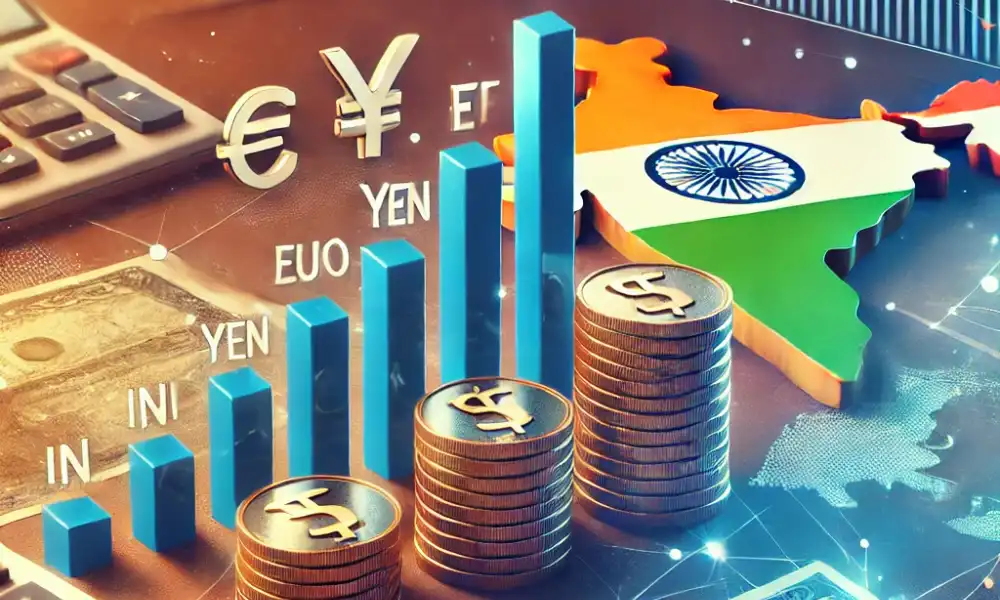Forex reserves India is currently adequate to fund more than 11 months of imports and 96% of country’s external debt as of Jun-2024.
The Reserve Bank of India (RBI) mentioned this in a recent bulletin of theirs and added that the economic base of India is still healthy even though it’s reserves have been up and down.
Forex Reserves: A Snapshot
As per the RBI data, the country’s forex reserves stood at USD 652.9 billion as of December 13, 2024. This is more by USD 6.4 billion in FY 2024-25. Reserves were a mixed bag for the week compared with a low level of $1.67bn a week ago in the most recent set of weekly data to date cited: a fall to $1.988bn.
Forex reserves had scaled an all-time high of USD 704.89 billion in the week ended September 3 but have fallen thereafter barring one after staying range-bound for many weeks. Nevertheless, despite these episodes of ups and downs in reserves, the RBI was quick to emphasize that the country still has comfortable reserves that can be utilised to protect the economy from the vagaries of FCNR(B) deposits.
Why Reserves Matter A foreign exchange reserve is a useful precaution for a nation.
Foreign reserves are a crucial component of our economy. These include foreign exchange reserves, gold, SDRs, and the Reserve Position in the IMF of the country’s central bank. India’s dollar reserves are mostly kept in Dollar, some in Euro, Yen or Sterling.
These deposits also serve multiple purposes:
- Import Coverage: They ensure that the country can pay for its imports without a break.
- Servicing Debts: They help in the servicing debts owed to foreigners.
- Resistant to Economic Crisis: Robust reserves absorb the turbulence of the world’s economy such as change in currencies, trade shortage etc.
- Strong Investors: Significant reserves can attract foreign investment by demonstrating that the economy is stable.
Why Are Reserve Levels Dropping?
The recent fall has been on account of the RBI’s attempts to stem the fall in the rupee. The Reserve Bank of India has also been intervening regularly selling dollars to keep the Rupee from falling too quickly. Such actions are to maintain order in the market, and avoid exchange sharp movement fluctuations.
For trade, investments and economic well-being, the Rupee is very important. A weak Rupee will make it tough for foreign investor and may also escalate the cost of imports hence have an impact on inflation, consumer spending.
History and Current Trends
A lot has happened in 10 years to the Indian Rupee, once one of the most volatile in Asia. Its central bank policymaking has helped it rise from the bottom of the regional list to one of the region’s most stable currencies.” The central bank has taken a two-pronged approach:
- Bargain shopping on dollars, in anticipation of a stronger Rupee, to conserve the same.
- Providing dollars when the Rupee depreciates to stabilise it.
- “The RBI’s aggressive monetary policy has not only put brakes on the rupee but has also made Indian assets attractive to global investors.
India’s forex reserves rose by nearly $58 billion in 2023, the exact opposite of a decline of almost $71 billion in 2022. This recovery is due to improved economic fundamentals and sound monetary policy.
The Road Ahead
India’s forex reserves is a tool to control the economy in With reserves that can cover 11 months of imports, the country is in a good position to meet any risks in the global trade or financial market.
This happy state, but it is happy only on the condition that it is defended – and this defense must be, a perpetual defense. Traditional and non-traditional risks from the external condition still complicate the global economic outlook: geopolitical risks; prices of commodities, which have growth volatility; and changes to policy rates in advanced economies.
The central bank’s intervention in the forex reserves and exchange rate volatility is required to steer through the uncertainties. Well a stable Rupee does more than save the local businesses from the ravages of currency volatility, it also encourages positioning in the global economy.
Robust and healthy India Reserves reflect India’s economic strength and good monetary management. While some recent volatility implies a lack of momentum, the status still seems a solid one. If we govern well and intervene at the right time India can be stable and it can attract investors from anywhere in the world.
For the people, a high forex reserve implies a stable economy, lower inflation, and more flexibility for trade and investment. It is a modest but powerful safeguard of the nation’s financial future, growth and stability to last generations.


